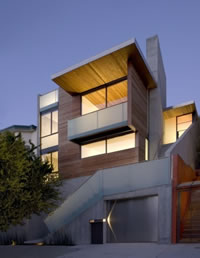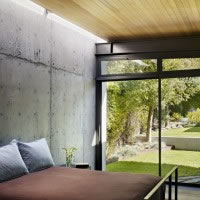BOSTON, October 4, 2010 – The hills of San Francisco, a beloved garden, and bountiful California sunlight converge in the award-winning Diamond Project, an innovative home designed in Archicad building information modeling (BIM) software.
 Built by Terry & Terry Architecture of Berkeley, Calif., the project won a 2010 AIA Housing Award, whose jury called it “crisp and sculptural, exquisitely detailed. It evokes a remarkable sense of nature in the middle of the city, [creating] a sense of space and seclusion in spite of the urban context.”
Built by Terry & Terry Architecture of Berkeley, Calif., the project won a 2010 AIA Housing Award, whose jury called it “crisp and sculptural, exquisitely detailed. It evokes a remarkable sense of nature in the middle of the city, [creating] a sense of space and seclusion in spite of the urban context.”
“Our overarching goal was to work with the site, not against it,” said Principal Alex Terry. “We wanted to take in all of its positive qualities – the garden, the views, the terrain and the light – blurring the boundaries of indoors and out. Archicad was essential in helping us work with the planes, the volumes, the tricky lighting and the sustainability considerations.”
The vegetable garden is so essential to the property that the first building in the project was transforming a dilapidated garden shed into an airy and elegant home office. Next came the home, which was an intriguing challenge on a steeply sloping hillside. Concrete walls along the side lot lines cradle the wooden structure, clad with ipé, a teak-like wood that is sustainably farmed in South America. Ceilings are red cedar native to California.
 A view of the hills
A view of the hills
A west-facing balcony overlooks the San Francisco hills, and sloped rooftops in both the back and front echo their ebbs and flows. Carefully designed ceiling gaps of 8 inches to two feet, protected by tempered glass, enable sun to illuminate interior walls and kitchen work areas without glare. Rooftop “sun scoops” draw more direct light into the bathroom. Concrete walls absorb heat from sunlight and the fireplace then slowly emit it in the evening to keep temperatures stable naturally.
Ceiling gaps illuminate interior walls – naturally
“Archicad’s powerful 3D visualization capabilities help us develop all these features quickly, but more importantly, we can delve more deeply into the project than we ever could working in two dimensions,” Terry said. “With Archicad, we all but live in the structure before we build it. Once you start working in 3D, the productivity, creativity and accuracy benefits are essential for trying new ideas and succeeding.”